You are viewing the Cultures of Knowledge Blog archive for the ‘Podcasts’ Category:
James Brown
July 17, 2012
Conferences and Workshops, Events, Podcasts, Project Updates
Tags: England, France, John Wallis, Martin Lister, Networks, Pierre Bayle, Pierre des Maizeaux
Convened by Philip Beeley and Martine Pécharman, the workshop is a letter-specific installment of the MFO’s ongoing series Across the Channel: Intellectual Relations between England and France in the Early Modern Period, and will feature epistolary talks from Antony McKenna (on Pierre Bayle), Anna Marie Roos (on Martin Lister), and Ann Thomson and Sébastien Drouin (on Pierre des Maizeaux). The workshop will be held at the Maison, and there’s no need to register; for further details, please visit the workshop webpage.
Kim McLean-Fiander
July 02, 2012
Events, Lectures, Podcasts, Project Updates, Publications
Tags: Cryptography, Editions, Elizabeth Stuart, Gender, Military History, Politics, Women
 Podcast available on the seminar page!
Podcast available on the seminar page!
Elizabeth Stuart, Queen of Bohemia (1596-1662) has often been portrayed as a romantic and frivolous figure; as a desperate, poverty-stricken, devout widow, or as a dilettante who spent her time going to ballets and masques and keeping the company of monkeys (which she allegedly enjoyed more than that of her children). A key constituent of these narratives has been the assumption that her political influence within Europe was negligible.
However, as Nadine Akkerman of Leiden University argued in her paper in our seminar series on 24 May (Opening up the Winter Queen’s Cabinet: The Correspondence of Elizabeth Stuart, Queen of Bohemia), this is a distorted and partial perception of the monarch that has largely arisen because historians have tended to overlook her vast correspondence. The fact is that Elizabeth’s nearly 1700 surviving letters from forty-seven archives in Europe and the US (estimated to be a mere 10% of what once existed) − which Nadine is editing for OUP − contain almost no information on her cultural life, and very little mention of plays, artists, or poets. They reveal instead that she was immersed in politics and was a keen follower of military affairs. Indeed, the underlying purpose of nearly all of her letters, Nadine argued, was to regain the lost Palatinate lands for her heirs.

Elizabeth, Queen of Bohemia
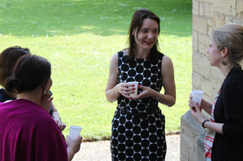
Nadine fields questions over drinks.
In a stimulating and wide-ranging analysis, Nadine discussed the often ignored, though politically important, roles of royal secretaries, scribes, and letter carriers. She traced the various ways by which Elizabeth attempted to outwit her brother Charles I’s surveillance of her correspondence (by using cryptography and steganography, for example), and suggested that Elizabeth used letters as a polite instrument by which to sabotage her brother’s plans for the Thirty Years War, thus making that event last ten years longer than it might otherwise have done. In sum, Nadine posited that an examination of this important though neglected correspondence should bring about an overdue reconfiguration of the Queen of Bohemia’s pivotal role in seventeenth-century diplomatic, military, and political history.
James Brown
June 12, 2012
Events, Lectures, Podcasts, Project Updates, Websites and Databases
Tags: Digitization, Editions, Electronic Enlightenment, France, Mapping the Republic of Letters, Networks, Text Mining, Visualization
 Podcast available on the seminar page!
Podcast available on the seminar page!
In the fourth paper of our seminar series on Thursday 17 May, Dr Glenn Roe – formerly of the University of Chicago, and current Mellon Fellow in Digital Humanities at Oxford’s OERC – gave a sophisticated and suggestive paper on ‘Text-Mining Electronic Enlightenment: Influence and Intertextuality in the Eighteenth-Century Republic of Letters’.
.
Building on his recent work with the Electronic Enlightenment corpus and other online repositories of long-form historical text, Glenn started his talk by observing the irony that the recent efflorescence of big data, culturomics, network analysis, and other quantitative approaches to culture – focusing in many cases on the macro interpretation of metadata over content – has authorized and promoted a convention of ‘not reading’ within the digital humanities, in which historical texts themselves can be marginalized or effaced altogether by the superabundance of information. The ready modelling of letters as a finite number of abstract datapoints (sender, recipient, and so on) and the vast quantities of diverse and often disorganized information exchanged within epistolary systems makes correspondence highly susceptible to such an approach.

Glenn during discussion.
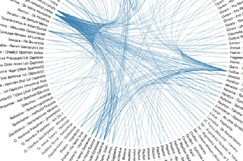
Visualizing influence.
As a supplement to this ‘distant’ reading, Glenn went on to demonstrate the potential of the latest machine-learning technologies to render significant volumes of transcription meaningful via text mining and the automated creation of patterns, frequencies, statistical models, and other forms of ‘mediated’ or ‘directed’ reading. Glenn distinguished between three kinds of text mining: predictive classification (used to generate new categories from unprocessed texts); comparative classification (used to correct and refine existing categories within processed texts); and similarity (used to measure broader similarities between documents and parts of documents, especially in terms of the identification of meaningful borrowing and instances of intertextuality). He then demonstrated each kind of approach within a rich series of examples drawn from his work with the ARTFL Encyclopédie Project, and most recently Electronic Enlightenment, before concluding his analysis by presenting – with caveats – some preliminary radial visualizations of textual influence generated using the D3 JavaScript library.
James Brown
May 25, 2012
Events, Lectures, Podcasts, Project Updates
Tags: Animals, Conrad Gessner, Felix Platter, History of Science, Illustration, Natural History, Networks, Sixteenth Century
 Podcast available on the seminar page!
Podcast available on the seminar page!
 The zoological theme continued on Thursday 3 May when Florike Egmond from Leiden University (formerly of the Clusius Project) gave a talk in our seminar series entitled The Webs of Clusius and Gessner: Correspondence, Images, and Collecting in Sixteenth-Century Natural History. In a detailed and lavishly illustrated discussion, Florike described her recent discovery of two albums of original watercolour drawings created for the sixteenth-century Swiss naturalist Conrad Gessner (1551-1558) within the Special Collections of the University of Amsterdam.
The zoological theme continued on Thursday 3 May when Florike Egmond from Leiden University (formerly of the Clusius Project) gave a talk in our seminar series entitled The Webs of Clusius and Gessner: Correspondence, Images, and Collecting in Sixteenth-Century Natural History. In a detailed and lavishly illustrated discussion, Florike described her recent discovery of two albums of original watercolour drawings created for the sixteenth-century Swiss naturalist Conrad Gessner (1551-1558) within the Special Collections of the University of Amsterdam.
Crafted in Basel by the anatomist and natural historian (and Gessner’s friend) Felix Platter (1536-1614), the images – of a menagerie of marine life, mammals, reptiles, and amphibians, across 369 pages – formed the basis of many of the illustrations within Gessner’s zoological masterwork, the Historiae Animalium (1551-1558). You can find out more about this exciting discovery in Florike’s recent blog post for the Picturing Science network, and in her recent article for the Journal of the History of Collections.
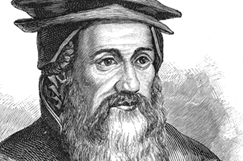
Conrad Gessner.
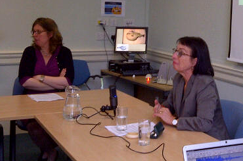
Anna Marie chairs Florike.
Renaissance correspondence networks, argued Florike, played a key role in sharing and disseminating (although not, curiously, in facilitating discussion of) manuscript images, as both Gessner, Clusius, and other naturalists solicited hand-drawn illustrations of animals to serve as the basis of woodcuts in their publications from colleagues and agents around the world. These exchanges, in turn, formed the basis of what Florike termed (with caveats) a kind of visual ‘canon formation’ within natural history, as elements of various portrayals were adapted, reworked, and reappropriated across different contexts and between media; as representational norms stabilized; and as the repertoire of animals deemed suitable for inclusion in zoological texts (whose wide remit originally encompassed familiar creatures such as cats and goats) was narrowed and standardized. A lively question and answer session focused on the artisanal communities responsible for producing the illustrations; how the works were commissioned and stored; and the frustrating but typical absence of any kind of discussion of manuscript images in the letters with which they circulated (resulting, suggested Florike, from the self-evident nature of enclosed materials).
Seminars take place in the Faculty of History on George Street on Thursdays at 3pm. For future talks in the series – and to listen to the podcast of Florike’s paper – please see the seminar webpage. All are welcome!
James Brown
May 14, 2012
Conferences and Workshops, Events, Exhibitions, Podcasts, Project Updates
Tags: Animals, Conchology, Frogs, History of Medicine, History of Science, Illustration, Insects, Martin Lister, Natural History, Ornithology, Royal Society, Seventeenth Century, Toads
Generously sponsored by the project, The Royal Society, The Wellcome Trust, the John Fell Fund, and the BSHS, sixty-three delegates attended the day-long event, which featured papers from eleven international authorities on early modern science. Speakers discussed everything from the views of French naturalists about the differences between dromedaries and camels, to the chequered history of the publication of the cabinet of natural curiosities of Albertus Seba, to the ornithology of Francis Willughby and John Ray and the scientific representation of frogs and toads.

Helen Watt, our Lhwyd researcher.

Perusing the exhibition.

Anna Marie talks to Jill Lewis.

Early modern ornithologies.
There was a concomitant exhibition in the Royal Society’s Marble Hall, also curated by Anna Marie, featuring a display of relevant books from the Society’s collections; highlights were a bear paw clam displayed alongside its illustration by Lister’s daughters in his Historiae Conchyliorum (1692-97), and John Ray’s Historia Plantarum, in which Ray deployed the terms ‘petal’ and ‘pollen’ for the first time. In a further exciting output, Anna Marie will guest edit a special conference issue of Notes and Records of the Royal Society (December 2012) dedicated to the complex interplay between seventeenth-century medicine and natural history. Dovetailing out from Lister’s own contributions, the special issue will consider to what extent practices and technologies of natural history changed between the Renaissance and the seventeenth century, and will explore how the acquisition of knowledge concerning the natural world and new taxonomies affected the perception and treatment of beasts for medical and experimental use.
Kim McLean-Fiander
May 13, 2012
Events, Lectures, Podcasts, Project Updates, Projects and Centres, Websites and Databases
Tags: Archives, Bess of Hardwick, Digitization, Editions, England, Gender, Materiality, Sixteenth Century, Women
 Podcast available on the seminar page!
Podcast available on the seminar page!

Alison fields questions.
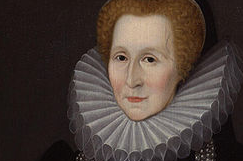
Bess in the 1590s.
Dr Alison Wiggins of the University of Glasgow got our third seminar series off to a brilliant start on 26 April with a sophisticated and thought-provoking presentation on Editing Bess of Hardwick’s Letters Online. As Principal Investigator of the Letters of Bess Hardwick Project (funded by the AHRC), Alison described the benefits and methodological challenges of digitizing this unique Renaissance correspondence, which consists of approximately 245 extant letters (160 to and 85 from Bess) scattered across 18 different repositories spanning a period of nearly 60 years.
Using several examples drawn from the corpus, Alison argued that making all of the letters available in an open-access, fully searchable online edition will enable scholars to pursue a wide range of linguistic, sociological, and historical questions, and will allow them to arrive at a much more comprehensive and nuanced understanding of the character of Bess herself, who has been variously depicted as a materialistic virago or as an admirable defender of women’s honour.
 Moving on to more methodological questions, Alison explained that capturing and communicating significant information on the material and visual features of letters, such as the writer’s use of ‘significant space’, paper quality and size, the employment of colourful silk ribbons and flosses, seal choice, and the many varieties of folding, can be particularly difficult in a digital environment, which has a tendency to reify disembodied text at the expense of the letter-object (concerns also raised by Henry Woudhuysen and James Daybell in previous talks). This is a significant problem, since such information is not just antiquarian micro-detail; on the contrary, for contemporary recipients, all of these carefully considered material decisions on the part of the sender conveyed specific social meanings about politeness, deference, and hierarchy which set important parameters for the reception and consumption of a letter’s written content. However, such physical variables and their nuances are not easy to capture faithfully with a simple measurement or colour chart reference in a metadata field. The solutions developed by Alison and her team in the context of the Bess project (such as encoding each of the four recognized kinds of letter-fold − tuck and fold, slit and band, accordion, and sewn − within each letter’s XML to facilitate searching and filtering by plicature and packet type) genuinely move forward thinking in this oft-neglected area and will be of great interest to other digital initiatives.
Moving on to more methodological questions, Alison explained that capturing and communicating significant information on the material and visual features of letters, such as the writer’s use of ‘significant space’, paper quality and size, the employment of colourful silk ribbons and flosses, seal choice, and the many varieties of folding, can be particularly difficult in a digital environment, which has a tendency to reify disembodied text at the expense of the letter-object (concerns also raised by Henry Woudhuysen and James Daybell in previous talks). This is a significant problem, since such information is not just antiquarian micro-detail; on the contrary, for contemporary recipients, all of these carefully considered material decisions on the part of the sender conveyed specific social meanings about politeness, deference, and hierarchy which set important parameters for the reception and consumption of a letter’s written content. However, such physical variables and their nuances are not easy to capture faithfully with a simple measurement or colour chart reference in a metadata field. The solutions developed by Alison and her team in the context of the Bess project (such as encoding each of the four recognized kinds of letter-fold − tuck and fold, slit and band, accordion, and sewn − within each letter’s XML to facilitate searching and filtering by plicature and packet type) genuinely move forward thinking in this oft-neglected area and will be of great interest to other digital initiatives.
Following a brief, appetite-whetting demonstration of the Bess letters alpha software, a lively question and answer session concluded the seminar, which covered such topics as the sociolinguistic significance of employing scribes and the iconographic implications of Bess using her ‘ES’ signature both in letters and as architectural embellishment on her stately home, Hardwick Hall. Broader concerns were also addressed, including the need for digital projects to produce REF-friendly outputs – an increasingly important theme – and ways of ensuring the preservation and accessibility of online resources long after project funding comes to an end. The soon-to-be-released Bess of Hardwick Letters Online will include annotated transcriptions of all of the letters and images of many, as well as articles and podcasts offering further contextual analyses of the correspondence. For news about its release date, stay tuned!
Seminars take place in the Faculty of History on George Street on Thursdays at 3pm. For future talks in the series – and to listen to the podcast of Alison’s paper – please see the seminar webpage. All are welcome!
Update: Podcasts now available!



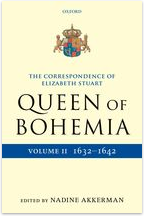


 The
The 

 In commemoration of the 300th anniversary of the death of
In commemoration of the 300th anniversary of the death of 





 Moving on to more methodological questions, Alison explained that capturing and communicating significant information on the material and visual features of letters, such as the writer’s use of ‘significant space’, paper quality and size, the employment of colourful silk ribbons and flosses, seal choice, and the many varieties of folding, can be particularly difficult in a digital environment, which has a tendency to reify disembodied text at the expense of the letter-object (concerns also raised by
Moving on to more methodological questions, Alison explained that capturing and communicating significant information on the material and visual features of letters, such as the writer’s use of ‘significant space’, paper quality and size, the employment of colourful silk ribbons and flosses, seal choice, and the many varieties of folding, can be particularly difficult in a digital environment, which has a tendency to reify disembodied text at the expense of the letter-object (concerns also raised by 
 Join
Join 